
Agile marketing is a tactical marketing approach in which marketing teams collectively identify high-value projects on which to focus their collective efforts. After each sprint, they measure the impact of the projects and then continuously and incrementally improve the results over time.
- What is Agile marketing?
- A History of Agile marketing
- How Agile marketing’s Sprint Zero ignited a movement
- Early arguments for Agile marketing
- Managing a manifesto
- The post-Manifesto years of Agile marketing
- How to implement Agile marketing
- What an Agile marketing department can do
- Should I implement Agile marketing?
- Agile marketing isn’t just about you
- Agile marketing requires Agile marketers
- Are my marketers willing to go Agile?
- Do you have cross-functional marketers?
- Real examples Agile marketing
- Conclusion
- Responding to Change When Following a Plan
- Fast iterations on big campaigns
- Testing and data on opinions and conventions
- Many small experiments at some big stakes
- Person and conversation in large markets
- Collaboration on silos and hierarchies
What is Agile marketing?
Agile marketing is a strategic marketing approach in which marketing teams collectively identify high-value projects to focus their collective efforts on.
Agile marketing teams use sprints (short, limited periods of intense work) to cooperatively complete those projects. After each sprint, they measure the impact of the projects and then continuously and incrementally improve the results over time.
Agile teams can also determine that a project was not valuable and should not be repeated, but it is still considered a success. Agile marketing embraces failure as long as it comes with lessons and builds potentially powerful projects of the future.
The way Agile marketing teams work becomes clearer when you look at what are commonly listed as the “values” of Agile Marketing:
You definitely need a comprehensive strategy to nail down your agile methods, but strategy is something that every marketing department should focus on, regardless of how they plan to implement it.
Whether you use collaborative or top-down methods to come up with your strategy, you can still bring it to life by using agile marketing techniques.
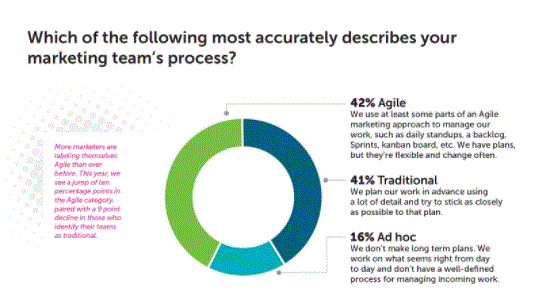
- On June 11, 2012, a fearless band of forward thinkers met to produce a document that would guide the future of modern marketing. Known as Sprint Xero, this two-day gathering of marketing stalwarts discussed the emerging concept of Agile Marketing. Their goal was to establish a shared understanding of core values and principles, as well as to illuminate the path of future evangelism around the movement.
- The main result of their 48-hour intensive meetings was the insightful Agile Marketing Manifesto, a thorough consolidation of many previous ideas, which is still the gold standard for what Agile Marketing really means. Sprint Zero recently celebrated its fourth anniversary, so it seems like an ideal time to take a look at the work of these clever guys and the early days of the movement.
A History of Agile marketing:
- The old Eventbrite description for Sprint Zero is still around, and it includes a description of the event: “SprintZero is a one-day free event that will bring together marketers who are passionate about Agile and incorporate it into their marketing practises. Our goal is to share, collaborate and discuss the latest best practises and operating principles of agile marketing. We also hope to explore how we can spread the word about the benefits of Agile to marketers.”
- More than 20 people gathered in San Francisco to spend two days focusing on agile marketing, presenting their ideas, successes, and failures with their fellow practitioners.
- As mentioned, the primary document that emerged from the gathering was the Agile Marketing Manifesto. But it also spawned dozens of articles and blog posts, fueling an ever-growing fire around the idea of turning marketing into an agile profession.
How Agile marketing’s Sprint Zero ignited a movement:
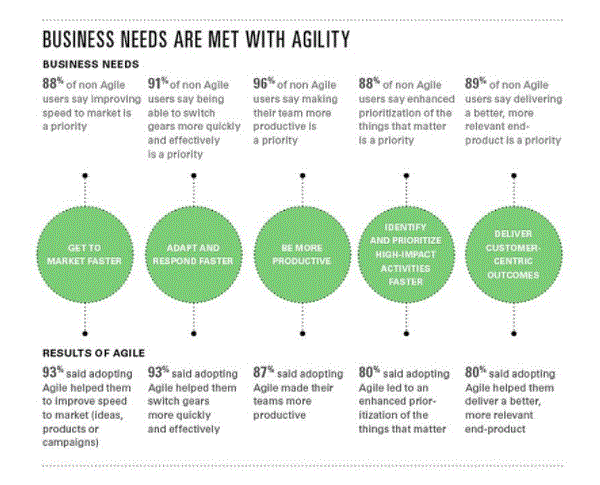
Early arguments for Agile marketing:
Before the end of Sprint Zero, many different people were putting forth their own version and approach of the Agile Marketing Manifesto. During 2011 and 2012 the base of the discussion was lively and important, but it was also creating a very wide variety of manifestos. Which one was “right”? What about those who seemed contradictory? How can agile marketing become a mature movement if we can’t argue about the values it should guide?
By 2012, it had become clear that if Agile Marketing was going to become a real movement, it needed a reference point. This was then the primary (and seriously lofty) goal of Sprint Zero.
- Agile software development produced its own Agile Manifesto in the early 21st century, and it was a catalyst to solidify that movement.
- Likewise, the 2012 Agile Marketing Manifesto has done much to wrap waggons around a central idea of what agility really means in marketing. Although you still see a lot of, “What is agile marketing?” Articles are popping up, almost as many on more specific, strategic topics.
- By taking the time to get a group consensus on what values should inform the agile marketing movement, the members of Sprint Zero have taken us to the next stage of the agile revolution.
Managing a manifesto:
- Nonetheless, many people ask why Agile Marketing hasn’t caught on like wildfire. If it’s such a great idea, the argument goes, then why the heck isn’t everyone and their dog doing it?. The answers lie in marketing as a profession.
- Its historical position within organisations has marginalised and silenced many marketing teams, forcing them to return to the conversation in recent years. It’s hard to fight for voice as well as learning a new agile language.
- On the other hand is the nature of marketers as individual professionals. “Old school” marketers a la Don Draper were a different breed of workers than their modern counterparts.
- Consider the number of marketers who were in the middle of their careers when digital marketing arrived, and it’s easy to understand how other forms of professional development have embraced the pace of change.
- Then, of course, there’s countering the 24/7 nature of marketing work. In short, the agile marketers who left Sprint Zero full of revolutionary enthusiasm were fighting an uphill battle.
The post-Manifesto years of Agile marketing:
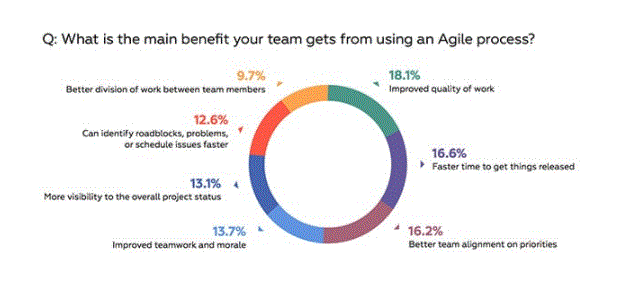
How to implement Agile marketing:
Apics, User Stories, Sprints, Scrum, Chickens, Pigs and Burndown Charts – Agile Marketing has a language of its own. How does Agile Marketing work anyway? Every marketing department will find the exact agile format that works best for them, but an agile marketing implementation will have these four characteristics in some form or fashion:
Sprint – A sprint is the amount of time you give your team to complete their current projects. Usually these last from two to six weeks. Some initiatives won’t fit in a sprint, so you’ll need to break them down into bite-sized pieces that you can tackle sprint by sprint.
Stand Up Meetings – Every day your team needs to come together and check in very briefly. This should be a maximum of 15 minutes. What each member of the team did the day before, what they plan to do today, and any blocks they encountered. Blocks should be addressed immediately.
Board to track project progress – whether it’s a nice ole’ whiteboard with sticky notes, a nice and simple kanban board, or a big fancy specialised software, you need a centralised way to track your sprint which is accessible to all.
Teamwork – While one person may “own” a project, the success or failure of a sprint depends on all members of the team. Everyone has to be ready to cooperate and assist in an agile marketing structure.
- Respond quickly to market changes
- Build fast campaigns that can be tested and optimised over time
- Try many things and repeat the ones that are successful
- Use input from other departments to enhance marketing efforts
- Justify choices in campaigns and projects with hard data
- Collaborate with team members to curate a tunnel-vision approach to marketing
- And that’s the high-level version of the list.
- When you start getting more specific and look at prospects on a project-by-project and sprint-by-sprint basis, the list of Agile marketing possibilities is almost endless.
What an Agile marketing department can do:
By following methods established by developers (with our own twists, of course), marketers can open up entirely new ways to reach audiences and goals.
Agile marketing allows marketers to:
- It’s important to spend some time pondering these big questions before you finish and budget a month on whiteboards and sticky notes, because your “why” should inform your “how.”
- Your team members may be overburdened by their excessive workload. If you are experiencing high turnover rates or seeing signs of burnout from your marketers, reducing the burden on your team should be your top priority.
- You don’t want to take an approach like Scrum that demands a lot of upfront learning or role changes; It’s just going to stress everyone out more.
- On the other hand, if your team is already healthy and stable, you may want to choose the method that will give you the most significant competitive advantage in the market. In this case, the scrum may be the perfect starting point.
- Take your marketing team Agile to consider what you hope to achieve, and choose a methodology that will lead you to those goals.
Should I implement Agile marketing?
Then again, your marketing team may not be a factor in your decision at all. If external interruptions regularly derail your projects and sabotage your deadlines, you need to build a wall around your work. Scrum’s structure and boundaries can be your saviour.
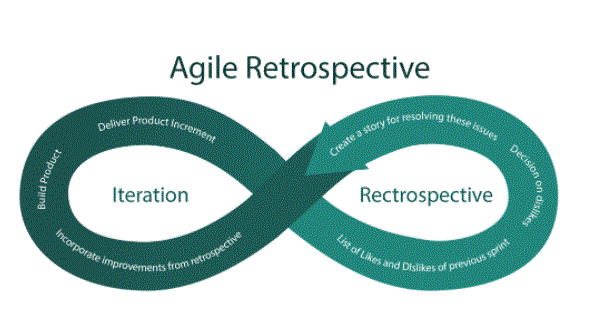
- Marketing is not a stand-alone profession; It is integrated at every level of a modern organisation. This means that marketing’s relationships with other departments should influence our agile changes.
- To resolve the confusion of your interdepartmental dynamics, think about your team’s level of political capital. Are other managers and executives confident that high-quality work will turn out when you ask, or do they see your deadlines and project details as fantasies?
- Marketing departments that haven’t earned trust, first and foremost, need to religiously focus on using agile processes to schedule and hit hits for several months. Once the level of political capital rises, continuous reform becomes easier, because stakeholders will give you more autonomy.
- If you’re already lucky enough to control your own marketing fortunes, you can start with the more serious workflow adjustments you’ll get from tools like the WIP limits used in Kanban and Scrumban. These give you quick results, but require an independent team.
- Think about the factors that affect your team, and make sure the methodology you choose aligns well with those relationships.
Agile marketing isn’t just about you:
Agile marketing requires Agile marketers:
Whatever method you choose, it is the people on your team who are going to make it work or sabotage it from within. Be realistic about the personnel you’re working with, and make smart choices about your agile marketing transformation based on your team, not what you want.
- Most importantly, evaluate your team’s willingness to change. If you have people who are at their wit’s end and willing to do anything to improve their professional lives, then Agile Marketing can seem like divine intervention. You won’t encounter much internal resistance, so you can look to the external factors we’ve outlined to guide your method of choice.
- If, however, your team is invested in the status quo and unwilling to experiment with alternatives to “the way we do things here”, you may have a battle on your hands. You will need to start with the lightest weight method available (ie, kanban) to try and reduce reluctance. Adaptability is important, but your team’s cross-functionality (or lack thereof) is almost as important as their openness to change.
Are my marketers willing to go Agile?
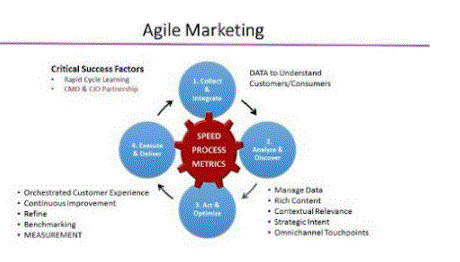
- Cross-functional marketing teams possess a variety of skills, particularly those that enable them to complete the full life cycle of projects. They can operate autonomously most of the time, relying little on other resources to move forward.
- The more cross-functional your team is, the higher their initial level of agility. There’s no reason why a highly specialised team can’t be agile; They will be more dependent on outside help to complete their work. Some methodologies, such as Scrum, are designed for highly cross-functional teams. Others, such as Scrumban and Kanban, can accommodate teams with more variation in skill sets.
- The classic formula for scrum teams is 7 members, plus or minus 2, but it doesn’t always break out on teams outside that range. Teams as small as 3 can use this method, and with some additional coordination, large departments can be split into multiple scrum teams.
- Kanban and Scrumban, on the other hand, scale up and down more easily. If you are new to Agile Marketing, choose Scrum only if your team size falls in the traditional 5-9 range. Otherwise, opt to start elsewhere and adopt scrum practises as needed.
- If you ask me, there aren’t many marketing teams that wouldn’t benefit from taking an agile marketing approach to their work. Some extra thought, patience, and experimentation should get you around any major obstacle.
- However, Agile Marketing was created to help manage the uncertainty around complex knowledge assignments. If you don’t have any uncertainty in your work—you know 100% of the requirements before you start and nothing ever changes as you work—then your team may not improve significantly at speed.
- I have a hard time imagining modern marketing work that isn’t complicated in at least a way, but it’s probably out there somewhere. Outside the team, reluctant executives can seem like insurmountable obstacles, but they are also manageable. They’ll just require you to be a little sneaky.
- Experimental programs—small, low-risk, visual experiments that you can run using agile methodology—are a great way to prove the value of change without the up-front buy-in. A pilot program requires a few marketers to execute, so you’ll need at least a handful of willing souls, but these types of initiatives are generally easier to shop for. Content marketing, social media, and online advertising all make great pilot candidates.
Do you have cross-functional marketers?
Team size matters:
Last, but certainly not least, the size of your team should inform your choice of methodology.
Marketing Teams That Shouldn’t Go Agile:
- Surveygizmo noticed that their current and potential customers were often searching for “survey examples,” but that their current offerings weren’t doing a good job of meeting that need.
- During a one-week sprint, he wrote six new guides for common survey types and created templates for surveys that customers could add to their accounts with a single click.
- Example landing page page views up 252%. The conversions earned from that page increased by 810%.
- Before Agile marketing processes, MarketerGizmo was creating content, but at a faster pace. Now that they can more accurately measure a team’s bandwidth with Agile Velocity, they can time each sprint to create and deliver content.
- On two different sites, their content output is now four times higher than it once was, without any loss of quality.
- MarketerGizmo has daily stand up meetings to check-in with their team, during which they identify any blocking issues that are preventing them from meeting their sprint goals.
- More than once, a team member will encounter an obstacle, either internal (a client needs my help!) Make sure it doesn’t suffer.
- This means that emails don’t go out late when someone gets sick, they don’t miss blog post deadlines because an editor gets pulled into a meeting, and any trips to the vet are theirs. Cannot remove targets. All team members are up to date on projects and progress, so they are empowered to make sure everything is done.
Real examples Agile marketing:
MarketerGizmo is exclusively using Agile marketing techniques, and their successes are beyond exciting. Here are just three of his early victories using an Agile marketing approach:
1. SurveyGizmo Example Page
2. Content Marketing Velocity
3. Group Accountability and Swarm Capacity
Conclusion:
These success stories may inspire you to run away and get fit right this very moment, and I won’t be the one to stop you, but I’ll remind you that it’s not a quick fix.It takes time to learn the ins and outs of a true Agile marketing system, and your first sprint will feel like a crawl. But in the long run, agile marketing can help marketing departments of any shape and size become more efficient, better serve their customers, and more fully integrated into the work of the business as a whole.
Agile is rapidly gaining momentum and popularity in marketing circles. This type of flexibility speeds up production and approval processes, minimises time spent in meetings, and maximises the time creative employees spend on actual creative work. Oddly, some marketing task management solutions have caught on to the trend and some can still handle multiple methods at once. If creative teams can find a solution that helps them manage their agile marketing process, they will be among the first to take advantage of this new and exciting trend.





